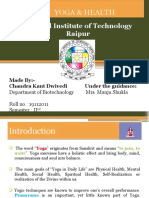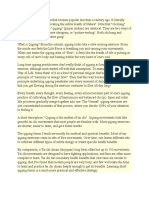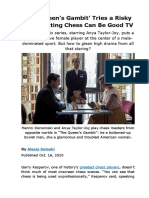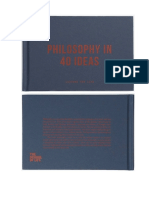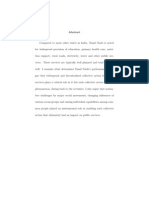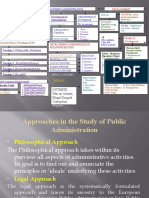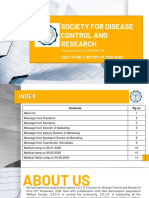0 ratings0% found this document useful (0 votes)
75 viewsHow To Breathe
How To Breathe
Uploaded by
Fabián BarbaThe document discusses the history and benefits of breathwork. It details how breathwork has been practiced for thousands of years in traditions like yoga, Buddhism and Bon. The author describes how they were inspired by Wim Hof's cold exposure method, which uses conscious breathing to reduce stress. The document outlines several benefits of breathwork like improving health, energy levels and reducing stress. It recommends practicing nasal breathing for its calming effects and greater oxygen uptake.
Copyright:
© All Rights Reserved
Available Formats
Download as DOCX, PDF, TXT or read online from Scribd
How To Breathe
How To Breathe
Uploaded by
Fabián Barba0 ratings0% found this document useful (0 votes)
75 views11 pagesThe document discusses the history and benefits of breathwork. It details how breathwork has been practiced for thousands of years in traditions like yoga, Buddhism and Bon. The author describes how they were inspired by Wim Hof's cold exposure method, which uses conscious breathing to reduce stress. The document outlines several benefits of breathwork like improving health, energy levels and reducing stress. It recommends practicing nasal breathing for its calming effects and greater oxygen uptake.
Original Description:
breathing
Original Title
How to breathe
Copyright
© © All Rights Reserved
Available Formats
DOCX, PDF, TXT or read online from Scribd
Share this document
Did you find this document useful?
Is this content inappropriate?
The document discusses the history and benefits of breathwork. It details how breathwork has been practiced for thousands of years in traditions like yoga, Buddhism and Bon. The author describes how they were inspired by Wim Hof's cold exposure method, which uses conscious breathing to reduce stress. The document outlines several benefits of breathwork like improving health, energy levels and reducing stress. It recommends practicing nasal breathing for its calming effects and greater oxygen uptake.
Copyright:
© All Rights Reserved
Available Formats
Download as DOCX, PDF, TXT or read online from Scribd
Download as docx, pdf, or txt
0 ratings0% found this document useful (0 votes)
75 views11 pagesHow To Breathe
How To Breathe
Uploaded by
Fabián BarbaThe document discusses the history and benefits of breathwork. It details how breathwork has been practiced for thousands of years in traditions like yoga, Buddhism and Bon. The author describes how they were inspired by Wim Hof's cold exposure method, which uses conscious breathing to reduce stress. The document outlines several benefits of breathwork like improving health, energy levels and reducing stress. It recommends practicing nasal breathing for its calming effects and greater oxygen uptake.
Copyright:
© All Rights Reserved
Available Formats
Download as DOCX, PDF, TXT or read online from Scribd
Download as docx, pdf, or txt
You are on page 1of 11
How to breathe
Whether your aim is improved health, mental calm or achieving
transcendence, breathing techniques can help you get there
You never know when you’re going to meet someone who will
change the course of your life. For me, it happened about five
years ago when, without knowing what I was getting myself
into, I signed up to a course in the Netherlands run by Wim Hof
– the legendary master of cold exposure.
Hof is an extraordinary teacher, best known for his world
records and other endurance feats, such as previously holding
the title for completing the longest-ever ice bath, running a
barefoot half-marathon in the Arctic Circle and climbing most of
Mount Everest dressed in shorts. One of the most important
elements of his method for making people fall in love with low
temperatures is what he calls ‘conscious breathing’. By
controlling the breath, he turns the experience of being in
freezing water, which would normally be a fight for survival,
into something profoundly meditative.
Back when I met Hof, my life was a constant struggle – I was
always getting ill, feeling depressed and generally unhappy. I
was looking for ways to improve my immune system and
increase my energy levels. I didn’t know then that the answer
to many of my questions would be this obvious: just breathe.
Respiration influences many of the processes in our body that
have a direct impact on our physical and mental health. Each
day, we take around 20,000 breaths, so over the years it adds
up. With every inhalation, our heart rate speeds up and with
every exhalation, it slows down. The nervous system is
especially sensitive to changes in breathing rate. Through our
breath, we can change our state from stress to relaxation, or
from feeling dull to being energised. Longer term, through
being more attentive to the way we breathe, we can benefit our
health and longevity. In short, we can change our breathing on
demand, which can be a hack to accessing the rest of our
physiology.
I was so inspired and transformed by what I learned from Hof
and others that I felt I had no choice but to pass it on to others
and, today, I work as a breathwork coach. What is breathwork?
It can be described as ‘breath consciousness’ and ‘conscious
breathing’. Every time we notice our breath or change our
breathing pattern to achieve a specific outcome, we are
practising breathwork.
Today, breathwork is the new yoga. It can be found everywhere
from therapy sessions to gym classes, but, while it’s currently
in vogue, it’s far from new. It’s hard to pinpoint the first
moment when humans decided to use breathing intentionally,
but you can find early indications of conscious breathing in
Hindu scriptures dating back hundreds of years, for instance in
the Bhagavadgita, composed sometime between the 2nd
century BCE and the 2nd century CE:
Still others, who are inclined to the process of breath restraint
to remain in trance, practise by offering the movement of the
outgoing breath into the incoming, and the incoming breath
into the outgoing, and thus at last remain in trance, stopping all
breathing. Others, curtailing the eating process, offer the
outgoing breath into itself as a sacrifice.
The Tibetan teachings of Tonpa Shenrab Miwoche that form the
basis of the Bon tradition, which considers the breath to be
important, are even older, dating back 18,000 years. Breathing
techniques have also been used in yoga for more than 2,000
years. In fact, breathwork has been present in nearly all
traditions and cultures: in mythology, philosophy, various
rituals, rites of passage, healing methods, spiritual and religious
practices, martial arts and meditation.
For many people, the breath is something much more than just
the purely physical movement of air. It is often described as
the energy, life force, cosmic essence, the vital principle that
permeates reality on all levels including inanimate objects. It is
the spirit or the soul. Different cultures refer to the same
phenomenon but by different names, such
as: prana, qi, ki, lung, ruach, spiritus, mana, rouh and pneuma.
In yoga, the breath is considered not only the path of spiritual
development, but also as a simple way of staying in good
health. In the yogic breathing pranayama, the practices are
well described, each with its own purpose – including
energising, cleansing or relaxing. For a long time, most
mainstream medical practitioners had no interest in
breathwork, but that began to change in the 1950s. For
instance, following his research into the ways that breathing
rate impacts health, Konstantin Buteyko, a Ukrainian-born
doctor, created a technique for dealing with breathing disorders
such as asthma, general breathlessness and rhinitis, and also
as a treatment for hypertension. His method was used in
hospitals across Russia. Now the ‘Buteyko method’, although
it’s considered a form of alternative medicine, is used across
the globe to treat breathing-pattern disorders. Overall, I believe
our modern understanding of the nervous system and scientific
studies are confirming that the yogic breathing practices have
their intended effect. We’re rediscovering what the yogis knew
a long time ago.
These days, athletes are also taking an interest in breathwork.
In sports, it’s always an arms race. Whoever finds a new way of
improving by a minuscule margin can have a huge advantage
over their competition. Athletes are turning to traditional yogic
breath-control practices as a means for conditioning the body
and strengthening the respiratory system – certain breathing
exercises can improve how efficiently the body uses oxygen.
Breathwork is especially pertinent to endurance sports. The
Buteyko method suggests that nasal breathing and breath-flow
restriction can help to raise the body’s tolerance to carbon
dioxide (CO2). Breath-holding methods have also been tested
widely as a way of increasing the load on the body and creating
beneficial long-term adaptations similar to altitude training.
Yet, despite the importance of the breath and the rising
popularity of breathwork, so many people never give any
consideration to this fundamental aspect of life. If it weren’t for
our autonomic nervous system, I bet many of us would
probably die by just forgetting to breathe while reading an
email. In this Guide, I will show you some basic breathwork
techniques. Whether you’re an Olympic-level athlete looking to
gain an edge, you’re struggling to cope with chronic anxiety or
you’re just curious, you’re breathing anyway, so why not start
to use your breath to your benefit? Even after having worked
with so many people, the potential of breathwork – a tool that’s
available to all of us – still blows my mind. It could be as simple
as learning a three-minute relaxation routine, or it could be the
start of a lifetime journey into self-development – either way,
welcome to breathwork.
Practise nasal breathing
If you’re extremely busy and don’t feel that you have much
time for breathwork, but you’d like to work on your breathing
to improve health and wellbeing, I suggest that you try
implementing one of the most basic of principles: practise
breathing through your nose rather than through your mouth.
This is something that you can do throughout the whole day…
and night.
Here are some benefits of nasal breathing:
It slows the incoming airflow, which has a calming effect on
the nervous system (specifically, it activates the
parasympathetic nervous system, which helps promote
calm and relaxation).
The air is travelling slower and stays longer in the alveoli,
where gas exchange happens. This gives oxygen more
time to diffuse in the bloodstream, which can result in 10-
20 percent greater oxygen uptake.
Your nose acts as a filter for pathogens, such as bacteria
and viruses.
The air going into the lungs is conditioned to better suit the
body – warmed up or cooled down, depending on the
external environment.
By breathing through your nose, you expel up to 40
per cent less water (meaning you’re less prone to
dehydration).
It avoids the problems associated with long-term excessive
mouth breathing, such as dental problems, inflammation
of the upper airways, forward head posture and even
changes in the shape of the jaw.
What if your nose is blocked? You should try to do everything
you can to unblock it. Sometimes it’s just a case of overcoming
the discomfort of the feeling of a shortness of breath. You
might be so used to mouth breathing that nasal breathing will
feel unnatural at first. But the more you breathe through your
nose, the easier it’s going to be. If you’re really struggling,
nose dilators, plasters or sprays (to clear the nostrils) will help
you in the early days and weeks. If you have a deviated
septum (a misalignment of the bone and cartilage that
separates the nostrils), which interferes with nasal breathing,
you might consider speaking to your doctor about having a
corrective operation.
If your nasal passages are just lightly blocked, you can help to
clear them using a simple exercise: perform a small exhale,
pinch your nose and hold your breath. During the peak of your
breath-hold, CO2 and nitric oxide will accumulate, both of which
are vasodilators, which will help the passages to unblock.
When should you be breathing through your nose? A good
instruction is to think about it in three phases:
1. Total nose breathing
2. Inhale nose, exhale mouth
3. Total mouth breathing
At rest and low intensity, you can be in phase 1 the entire time.
When you start moving or even lifting heavy things, you can try
to stay in this phase as long as possible. At a point where the
effort becomes too hard, then move to phase 2. If you increase
the load even more, getting closer to your maximum capacity,
then phase 3 will be necessary. Once the effort decreases, you
can go back to phase 2 and 1, respectively.
Practise diaphragmatic breathing
Another basic step that you can take in life to improve your
breathing is to consider your posture. It works both ways – bad
posture will restrict your breathing, and disrupted breathing
patterns can negatively influence your muscular system. To
better manage our posture, we need to take a closer look at
the diaphragm, which plays a key role in core stabilisation. It’s
a big, dome-shaped muscle situated under our ribs that divides
the thoracic and the abdominal cavities. When you inhale, the
diaphragm moves down creating the difference in pressure in
your lungs and pulling in air. When you relax, the diaphragm
moves up and the air goes out. Here lies the guidance to
natural breathing – the inhalation is active, drawing the air in
and the exhalation is passive, as you just relax and don’t have
to push the air out.
To develop a healthy diaphragmatic breathing pattern try the
following exercise:
1. Lie down on your back or sit comfortably on the floor or in
a chair. You can place your hands on your body for tactile
feedback.
2. Bring your attention to the inhale, observing your belly
expanding while the air is being pulled into your lungs.
While this happens, your upper chest and shoulders should
remain still.
3. Each exhalation is passive – just relax and the air goes
out; there’s no need to push.
4. Go into a steady rhythm of active inhalation and relaxing
exhalation.
5. After a short while, once it becomes effortless, move your
attention to the sides of the abdominal area around the
lower ribs. Try to engage the lower ribs – with every
inhalation they should be expanding slightly to the sides.
This will be a more subtle movement than in the front.
6. After spending another few minutes in this area, focus on
your lower back. Imagine that, with every inhalation, the
lower back is gently activated, and with every exhalation it
relaxes.
7. With time, you will be able to effortlessly combine these
three areas (front, sides and back) so that the expansion
during inhalation is felt not only in the front of the belly,
but 360 degrees around your body.
8. If at first you don’t feel any activation of your ribs or your
lower back, don’t worry, give it some time.
9. Spend a few minutes each day practising this and just
breathe normally for the rest of the time. Even when
you’re not focused on your breathing, with time you’ll find
that it becomes fuller and more relaxed.
Compared with shallow chest-breathing, diaphragmatic
breathing has various benefits. It’s more relaxing and it makes
the process of gas exchange more efficient. The oxidative
stress caused by mental or physical exhaustion can
be mitigated by diaphragmatic breathing. We often hear that
breathing can improve our immune system, and there’s some
truth to this. Diaphragmatic breathing helps to move the lymph
(the fluid that flows through the lymphatic system), therefore
moving pathogens through the lymph nodes where they can be
treated with specific lymphocytes. Another benefit is the
increased blood flow to the heart. Finally, if you strengthen the
diaphragm as a muscle (through regular diaphragmatic
breathing), you’ll increase your physical endurance.
Practise rhythmic breathing
With practice, breathwork can help give you a degree of control
over your stress response, one of the most important
superpowers you can imagine. Since your body is governed by
rhythms – your nervous system picks up the steady flow of air
as a cue for safety and adjusts other bodily processes
accordingly – you can use this to your advantage.
One way is via a common practice in yoga, in which we breathe
in and out to a count. The aim is to find a comfortable length of
the breath and, once it becomes easy, the rhythm can be
slowed down. Usually, after a few minutes of rhythmic
breathing, you will feel the shift to your body’s parasympathetic
nervous system, the branch of the autonomic nervous system
that not only helps our bodies repair and recover, but also
improves our social engagement. Rhythmic breathing has also
shown promise in helping to treat depression and anxiety.
Here’s how to give it a go:
1. Find a comfortable position, sitting or lying down. Close
your eyes and breathe through your nose.
2. Focus on diaphragmatic breathing.
3. Slow your breath down so that you follow a pattern of
inhaling for 6 seconds and exhaling for 6 seconds.
4. If this is too hard, pick a shorter count such as 3 or 4
seconds in, and the same out.
5. Keep this rhythm for a few minutes, staying relaxed and
focused.
6. When the 6-seconds rhythm becomes easy, you can try to
extend the length to 8 seconds, 10 seconds, or even
longer. Also, for a greater relaxation effect, you could try
breathing out for twice as long as you breath in.
If you spend time practising this form of breathing when all is
well, you will find it more effective when you use it to calm
yourself during moments of unease.
Build your carbon dioxide tolerance
One of the most significant things that you can do for your
mental processes is to get the right amount of oxygen into your
brain and vital organs. The rate of your breath holds the key to
that. What you’re looking for is slow and gentle breathing.
When our breathing is fast and shallow, we’re mostly moving
the air in the ‘dead space’, which is the volume of air that
doesn’t take part in the gas exchange (it isn’t utilised by the
body). This is why we want slow and deep breathing, which
gives us a much better gas exchange.
Carbon dioxide (CO2) is the gas in air that triggers a faster
breathing rate – we have a natural instinct to expel it from our
system – so one key to slowing our breath down is to get more
accustomed to CO2. We often think of CO2 as something
negative, a by-product that we have to get rid of. However,
CO2 plays a very important role in our body as a vasodilator. It
also helps to release oxygen from the blood, which is known as
the Bohr effect. This is why increasing your body’s tolerance to
CO2 can be beneficial, helping your cells’ uptake of oxygen.
When you exhale through your nose, you keep more CO 2 than
when exhaling through your mouth, so practising nasal
breathing as often as possible is the first step. Beyond that, to
be more in control of your breath, whether you’re dealing with
asthma or improving your sports performance, you should
focus on improving your tolerance to CO 2. The ‘breathe light’
exercise from the Buteyko method that I mentioned earlier is
perfect for this (to ensure your safety, check with your doctor
before trying this exercise):
1. Start in a comfortable seated position. Keep your eyes
open or, if it helps you to focus more on the breath, then
keep them closed.
2. While breathing lightly through your nose, observe the
volume of air that you’re breathing in and out.
3. Start to reduce the depth of your breath by about 20-30
per cent, to the point where you start to feel a slight air
hunger but not panic (your breathing rate should stay the
same, at its usual resting level). If you reduce the depth
of breath too much, to the point of strong discomfort, go
back to normal breathing, reset and start to reduce again.
4. Find a balance where you can feel a slight air hunger, but
can continue breathing like this for 5-10 minutes.
Always, when practising, make sure that your whole body is
relaxed. If you’re new to breathwork, start slowly and gently,
and progress only when you feel comfortable. Once you get the
hang of this, you can practise this daily.
According to the Buteyko method, as you raise your tolerance
to CO2, your breathing becomes lighter and more effortless,
and your average breathing rate slows down. Practitioners also
suggest that this process facilitates the release of oxygen from
haemoglobin into the cells, as well as helping to improve your
blood circulation. If you have an active lifestyle, it’s a great way
to increase your endurance and delay the moment of fatigue.
Practise breath-holding (with a qualified teacher)
In yoga, the practice of breath retention called kumbhaka has
been used for hundreds of years. Many masters have pointed to
the fact that practising regular breath retention can result not
only in greater health but also in enhanced stamina. Modern
scientific findings are providing tentative support for
this, showing that a few breath-holds can trigger several
mechanisms that help us to stay without air for longer. During
breath retention, our spleen contracts, releasing blood that’s
very rich in oxygen-carrying red blood cells. We also experience
a release of the hormone erythropoietin, which not only further
increases the red blood-cell count, but increases the efficiency
of mitochondria.
When working with active people, many times I’m asked the
question: ‘How can I increase my physical performance through
breathing?’ It turns out that a conscious breath-hold can be one
of the most powerful tools available for this purpose. Athletic
performance correlates with the amount of oxygen that can be
transported and utilised, and training in breath-holding can
build this capacity.
The use of altitude training in sports to improve physical
performance is based on similar principles. Being in a low-
oxygen zone (or ‘hypoxia’) forces our body to adapt, so that,
after returning to sea level, we can enjoy the benefits of
increased performance. Breath-holding effectively simulates
this kind of environment. The ‘exhale-hold’ or ‘altitude-
simulation’ technique can be used to drop the oxygen
saturation in your body, if only for a brief moment. As part of a
training programme, even these short moments in hypoxia can
build up to a meaningful advantage. Since breath retention is a
complex technique, I always recommend that you should learn
it with a qualified teacher. Your teacher will show you how to
perform a maximum breath-hold after a light exhalation
(leaving about 30-40 per cent of the air in your lungs). For safe
and effective training, your teacher should use a pulse oximeter
to monitor your oxygen levels.
You might also like
- Unlocking the Power of Emotions: A Comprehensive Guide to Body Healing with Emotion Code TherapyFrom EverandUnlocking the Power of Emotions: A Comprehensive Guide to Body Healing with Emotion Code TherapyNo ratings yet
- FYM Take 5 Years Off Your Face PDFDocument16 pagesFYM Take 5 Years Off Your Face PDFTangri La PRopagands89% (9)
- Anuloma VilomaDocument3 pagesAnuloma VilomaHazelNo ratings yet
- Yoga & Health: National Institute of Technology RaipurDocument15 pagesYoga & Health: National Institute of Technology Raipurindu kant dwivediNo ratings yet
- KayasthairyamDocument3 pagesKayasthairyamdaniel_velez702543100% (2)
- TeachingsonHathaRajaYoga 1Document294 pagesTeachingsonHathaRajaYoga 1rhvenkatNo ratings yet
- Yoga Pranayama (Breathing Excercise) : Pranayama: The 4th of Eight Limbs of YogaDocument15 pagesYoga Pranayama (Breathing Excercise) : Pranayama: The 4th of Eight Limbs of YogaGowtham PNo ratings yet
- Swim DragonDocument3 pagesSwim DragonMatias MugenNo ratings yet
- AhimsaDocument3 pagesAhimsamioko05031997100% (1)
- Alain de Botton - 22 QUESTIONS TO REIGNITE LOVEDocument14 pagesAlain de Botton - 22 QUESTIONS TO REIGNITE LOVEFabián Barba100% (1)
- StereotypeDocument5 pagesStereotypejanella tatingNo ratings yet
- Annual Barangay Youth Investment PlanDocument22 pagesAnnual Barangay Youth Investment Plananon_761094444No ratings yet
- ARK ETF Trust Annual ReportDocument62 pagesARK ETF Trust Annual ReportTam Jack100% (1)
- Instruction: Encircle The Letter of The Best AnswerDocument7 pagesInstruction: Encircle The Letter of The Best AnswerDENNIS ZOZOBRADO100% (13)
- BreathingDocument46 pagesBreathingRamnaresh SharmaNo ratings yet
- 3 Step Rhythmic Breathing For Inner EvolutionDocument6 pages3 Step Rhythmic Breathing For Inner Evolutionypshinde80100% (1)
- Rhythm: AIR and INCOMING IMPULSES - To The Tension Required For That System ToDocument2 pagesRhythm: AIR and INCOMING IMPULSES - To The Tension Required For That System TogsmnaiduNo ratings yet
- One Life Five Precepts Buddhist Ethics For Modern LivingDocument96 pagesOne Life Five Precepts Buddhist Ethics For Modern LivingGediminas GiedraitisNo ratings yet
- 108 Quotes of BabaDocument4 pages108 Quotes of BabaPRASANTH G KRISHNANNo ratings yet
- Kriya YogaDocument24 pagesKriya YogaVenugopal100% (1)
- Yoga Synergy Founder ArticleDocument5 pagesYoga Synergy Founder ArticleTest4DNo ratings yet
- Refining ExercisesDocument14 pagesRefining Exercisesypshinde80100% (1)
- QigongDocument7 pagesQigongFrank ValenzuelaNo ratings yet
- Suhas TambeDocument13 pagesSuhas TambeAnuj TiwariNo ratings yet
- The Buddha TeachesDocument7 pagesThe Buddha TeachesRavi PujNo ratings yet
- Layman Guide To Surya NamaskarDocument3 pagesLayman Guide To Surya NamaskarsunilmansinghNo ratings yet
- North America Institute of Vihangam YogaDocument20 pagesNorth America Institute of Vihangam Yogasahayrajesh100% (1)
- Integration of Health With Indian Traditional ScienceDocument3 pagesIntegration of Health With Indian Traditional ScienceIJAR JOURNAL100% (1)
- Yoga Course by SR at KanpurDocument14 pagesYoga Course by SR at KanpurswamiramaNo ratings yet
- Science of BreathDocument42 pagesScience of BreathArvindChauhanNo ratings yet
- The Gopuram Over The Entrance To The Guhai Namasivaya TempleDocument31 pagesThe Gopuram Over The Entrance To The Guhai Namasivaya TemplevenkataramansNo ratings yet
- Shashankasana - Hare Posure & Balasana - Child's PostureDocument10 pagesShashankasana - Hare Posure & Balasana - Child's Posturegaya3mageshNo ratings yet
- Library of Teachings - Preparatory Exercises For Lungs Magnetic Field and Deep Meditation - ©the-Teachings-Of-Yogi-BhajanDocument7 pagesLibrary of Teachings - Preparatory Exercises For Lungs Magnetic Field and Deep Meditation - ©the-Teachings-Of-Yogi-BhajanValentinaZoccaNo ratings yet
- Surya NamaskarDocument4 pagesSurya NamaskarRAJESH MENON100% (1)
- CommonGround 8 26 BrierleyDocument84 pagesCommonGround 8 26 Brierleytuinbroek_94397869No ratings yet
- Lesson 12Document33 pagesLesson 12Marykris CamachoNo ratings yet
- Brah Macharyas An ADocument2 pagesBrah Macharyas An Aavtar_singh450No ratings yet
- 15 SuryaYog - e BookDocument15 pages15 SuryaYog - e BookAmit Bassi100% (1)
- Ahimsa. Non-ViolenceDocument3 pagesAhimsa. Non-ViolenceHamsa100% (1)
- The External KumbhakaDocument2 pagesThe External Kumbhakaumeshkr1234No ratings yet
- Yoga AsanaDocument14 pagesYoga AsanaVipin MishraNo ratings yet
- Kirtan Kriya ResearchDocument2 pagesKirtan Kriya ResearchÉrika PretesNo ratings yet
- Physical Education (Yoga)Document8 pagesPhysical Education (Yoga)rebornkai09100% (1)
- Yoga - Routine: by Khun ReinhardDocument12 pagesYoga - Routine: by Khun Reinhardoidane100% (2)
- SatKriya WorkoutDocument1 pageSatKriya WorkoutNagaraju JallaNo ratings yet
- Yoga Training Proposal - IIT BhubaneshwarDocument5 pagesYoga Training Proposal - IIT BhubaneshwarDeboo X XavierNo ratings yet
- YOGADocument25 pagesYOGASahil Chauhan100% (1)
- PJ Saher - ZenYogaDocument331 pagesPJ Saher - ZenYogaSadhu SadanandNo ratings yet
- How I Bypassed My Bypass-SurgeryDocument4 pagesHow I Bypassed My Bypass-Surgeryharinag49No ratings yet
- Swami Ramdev's Eight Pranayam For Health and Tranquility.Document6 pagesSwami Ramdev's Eight Pranayam For Health and Tranquility.abckadwaNo ratings yet
- Effect of Sky Yoga On Blood Sugar Levels of Diabetic PatientsDocument8 pagesEffect of Sky Yoga On Blood Sugar Levels of Diabetic PatientsGopal KrishnanNo ratings yet
- Asana Presentation Jigna KhambhadiaDocument5 pagesAsana Presentation Jigna KhambhadiaJigna KhambhadiaNo ratings yet
- Yogasanas: Simple aasans that keep you fit and healthyFrom EverandYogasanas: Simple aasans that keep you fit and healthyNo ratings yet
- Yoga SutrasDocument11 pagesYoga Sutrassatya narayan mahawarNo ratings yet
- Lucas Rockwood Eng-Ro TradDocument10 pagesLucas Rockwood Eng-Ro TradCoco AleNo ratings yet
- Yoga Guide For Menopause: Yoga's Unique Benefits During The Menopausal YearsDocument4 pagesYoga Guide For Menopause: Yoga's Unique Benefits During The Menopausal YearsDoinaNo ratings yet
- Level 4 Yoga MaterialDocument14 pagesLevel 4 Yoga MaterialBaruni J SNo ratings yet
- Sivananda Yoga AaaDocument43 pagesSivananda Yoga AaaAdelfadelfNo ratings yet
- Hatha-Yoga HT PDFDocument4 pagesHatha-Yoga HT PDFJayaprakash ParamasivamNo ratings yet
- Sitting With The Body - Orit Sen-GuptaDocument11 pagesSitting With The Body - Orit Sen-GuptaedmundlewakNo ratings yet
- Jalandhara Bandha (Net-Bearer Bond)Document2 pagesJalandhara Bandha (Net-Bearer Bond)yogavashisthaNo ratings yet
- Nadi Shuddhi PranayamaDocument7 pagesNadi Shuddhi Pranayamapfrzdn100% (1)
- Mindful Recovery: A Case Study of A Burned-Out Elite ShooterDocument12 pagesMindful Recovery: A Case Study of A Burned-Out Elite ShooterRandy HoweNo ratings yet
- Alain de Botton - A NON-TRAGIC VIEW OF BREAKING UPDocument4 pagesAlain de Botton - A NON-TRAGIC VIEW OF BREAKING UPFabián Barba100% (1)
- The Queen's Gambit'Document41 pagesThe Queen's Gambit'Fabián Barba100% (1)
- Alain de Botton - PHILOSOPHY IN 40 IDEAS Lessons For LifeDocument79 pagesAlain de Botton - PHILOSOPHY IN 40 IDEAS Lessons For LifeFabián BarbaNo ratings yet
- 100 Civics (History and Government) Questions For The Naturalization TestDocument15 pages100 Civics (History and Government) Questions For The Naturalization TestFabián BarbaNo ratings yet
- Adam Gopnik - The Troubling Genius of G. K. ChestertonDocument20 pagesAdam Gopnik - The Troubling Genius of G. K. ChestertonFabián BarbaNo ratings yet
- Alain de Botton - On AnxietyDocument69 pagesAlain de Botton - On AnxietyFabián Barba100% (1)
- Alain de Botton - PHILOSOPHY IN 40 IDEAS Lessons For LifeDocument79 pagesAlain de Botton - PHILOSOPHY IN 40 IDEAS Lessons For LifeFabián BarbaNo ratings yet
- Alain de Botton - ON ARGUINGDocument3 pagesAlain de Botton - ON ARGUINGFabián BarbaNo ratings yet
- Alain de Bototn - Pygmalion and Your Love LifeDocument10 pagesAlain de Bototn - Pygmalion and Your Love LifeFabián BarbaNo ratings yet
- The Confidence Gap For Girls - 5 Tips For Parents of Tween and Teen GirlsDocument6 pagesThe Confidence Gap For Girls - 5 Tips For Parents of Tween and Teen GirlsFabián BarbaNo ratings yet
- Alain de Botton - On Arguing More NakedlyDocument5 pagesAlain de Botton - On Arguing More NakedlyFabián BarbaNo ratings yet
- 2008-2012 Shaye Cohn Videos CatalogueDocument5 pages2008-2012 Shaye Cohn Videos CatalogueFabián BarbaNo ratings yet
- 9 Reasons Why "Annihilation" Is One of The Best Sci-Fi Films of The 21ST CenturyDocument15 pages9 Reasons Why "Annihilation" Is One of The Best Sci-Fi Films of The 21ST CenturyFabián BarbaNo ratings yet
- BY THE BOOK America Ferrera - by The Book Sept. 27, 2018Document5 pagesBY THE BOOK America Ferrera - by The Book Sept. 27, 2018Fabián BarbaNo ratings yet
- Rethinking Infidelity - Skye C. Cleary Interviews Esther PerelDocument10 pagesRethinking Infidelity - Skye C. Cleary Interviews Esther PerelFabián BarbaNo ratings yet
- Michael Shermer - HAVE ARCHETYPE - WILL TRAVEL : THE JORDAN PETERSON PHENOMENONDocument16 pagesMichael Shermer - HAVE ARCHETYPE - WILL TRAVEL : THE JORDAN PETERSON PHENOMENONFabián Barba100% (1)
- Books That Made Me Robin Robertson - The Poetry World Is Polarised. I'm in The Middle, Vaguely Appalled' 28 Sep 2918Document4 pagesBooks That Made Me Robin Robertson - The Poetry World Is Polarised. I'm in The Middle, Vaguely Appalled' 28 Sep 2918Fabián BarbaNo ratings yet
- The 20 Most Beautiful Movie Scenes of All TimeDocument23 pagesThe 20 Most Beautiful Movie Scenes of All TimeFabián BarbaNo ratings yet
- Five Famous Faulkner FablesDocument13 pagesFive Famous Faulkner FablesFabián BarbaNo ratings yet
- Read 10 of The Best Stories Ever Published in PlayboyDocument7 pagesRead 10 of The Best Stories Ever Published in PlayboyFabián BarbaNo ratings yet
- 10 Movie Masterpieces You've Probably Never SeenDocument13 pages10 Movie Masterpieces You've Probably Never SeenFabián BarbaNo ratings yet
- 31 Movies Based On Short StoriesDocument33 pages31 Movies Based On Short StoriesFabián BarbaNo ratings yet
- Being and Drunkenness - How To Party Like An ExistentialistDocument5 pagesBeing and Drunkenness - How To Party Like An ExistentialistFabián BarbaNo ratings yet
- What's Your True Sexual Orientation - The Purple-Red Scale Is Here To Help You Find OutDocument7 pagesWhat's Your True Sexual Orientation - The Purple-Red Scale Is Here To Help You Find OutFabián BarbaNo ratings yet
- Child Study Report DSWDDocument2 pagesChild Study Report DSWDPablo Eschoval100% (4)
- Health Education Grade 7 Designs January 2022Document70 pagesHealth Education Grade 7 Designs January 2022maureentheru48No ratings yet
- Romania - CEI Extraordinary Call For Proposals 2020 AF - 0Document8 pagesRomania - CEI Extraordinary Call For Proposals 2020 AF - 0Nicoleta Popa-FoteaNo ratings yet
- Renal Trauma and Renal SurgeriesDocument49 pagesRenal Trauma and Renal SurgeriessanthiyasandyNo ratings yet
- Abdominal Massage For Constipation Relief in Stroke Patient - 2021 - Enfermer ADocument5 pagesAbdominal Massage For Constipation Relief in Stroke Patient - 2021 - Enfermer ADmytro ChopovskyiNo ratings yet
- Understanding Public Services in Tamil Nadu: An Institutional PerspectiveDocument433 pagesUnderstanding Public Services in Tamil Nadu: An Institutional PerspectiveVivek SrinivasanNo ratings yet
- Brain Life and Brain Death: A Proposal For A Normative AgreementDocument15 pagesBrain Life and Brain Death: A Proposal For A Normative AgreementStamenko S. SusakNo ratings yet
- Ce Booklet Fall 14Document28 pagesCe Booklet Fall 14api-279863771No ratings yet
- Volunteer Services Manager Coordinator in Chicago IL Resume Susan AtkinsonDocument2 pagesVolunteer Services Manager Coordinator in Chicago IL Resume Susan AtkinsonSusanAtkinson2No ratings yet
- Overview of Public AdministrationDocument89 pagesOverview of Public Administrationnadja mujaNo ratings yet
- Operating Instructions: EpilatorDocument7 pagesOperating Instructions: EpilatorMohamed HassanNo ratings yet
- 6 The Physical SelfDocument7 pages6 The Physical SelfMicsjadeCastilloNo ratings yet
- Special Area Plan Urban Design & Planning ControlDocument14 pagesSpecial Area Plan Urban Design & Planning Controlazelea92100% (1)
- Penta ValenDocument328 pagesPenta ValenAnti Nub GamingNo ratings yet
- Which Is A Thesis Statement?Document3 pagesWhich Is A Thesis Statement?Rodessa Marie Canillas LptNo ratings yet
- Bellhouse Doré 1988Document9 pagesBellhouse Doré 1988Manuel VillasanaNo ratings yet
- Family CounsellingDocument10 pagesFamily Counsellingindians risingNo ratings yet
- Managing The Manual Handling RiskDocument24 pagesManaging The Manual Handling RisksayedmhNo ratings yet
- Look Alike Sound Alike Medications in PharmacyDocument8 pagesLook Alike Sound Alike Medications in PharmacycherylNo ratings yet
- Sample FNCP Accident HazardDocument2 pagesSample FNCP Accident HazardMichael PiducaNo ratings yet
- Pre Gestational ConditionsDocument68 pagesPre Gestational ConditionsQuinonez Anna MarieNo ratings yet
- Online Prelims Test - 16 (Subject Wise) : (Insightsias Mock Test Series For Upsc Preliminary Exam 2020)Document24 pagesOnline Prelims Test - 16 (Subject Wise) : (Insightsias Mock Test Series For Upsc Preliminary Exam 2020)Saurav MedhiNo ratings yet
- SDCR Half Yealry ReportDocument18 pagesSDCR Half Yealry ReportAbbas AliNo ratings yet
- What Is An Expository EssayDocument8 pagesWhat Is An Expository Essayb71bpjha100% (2)
- Rhetorical Analysis English 1010 Final DraftDocument5 pagesRhetorical Analysis English 1010 Final Draftapi-537255193No ratings yet



